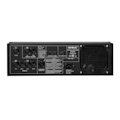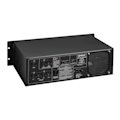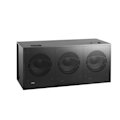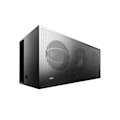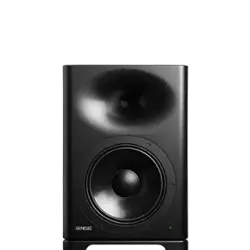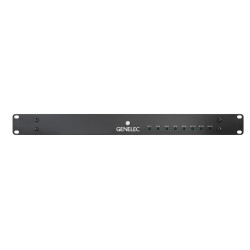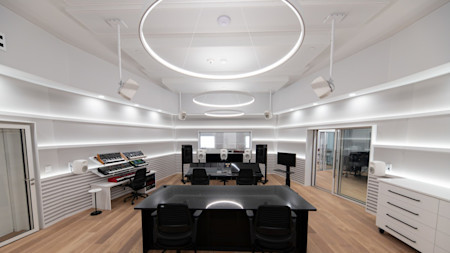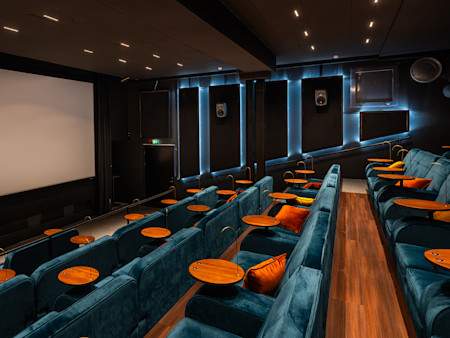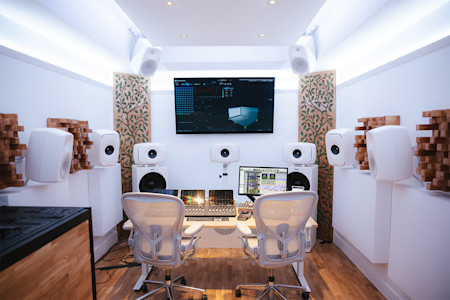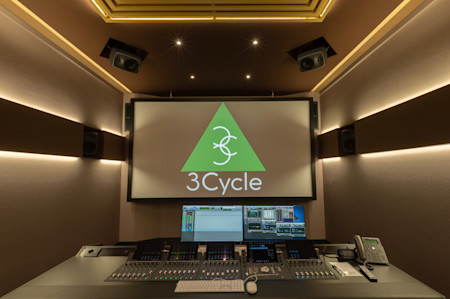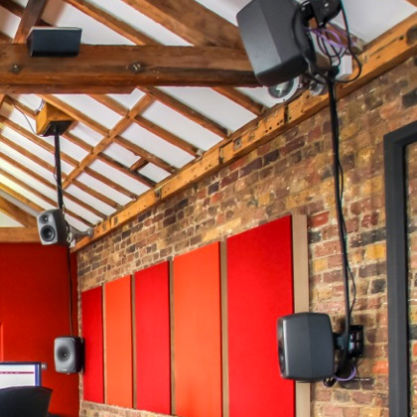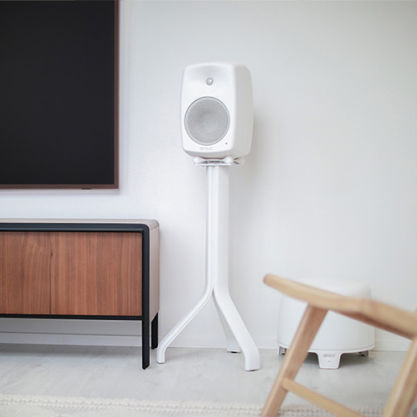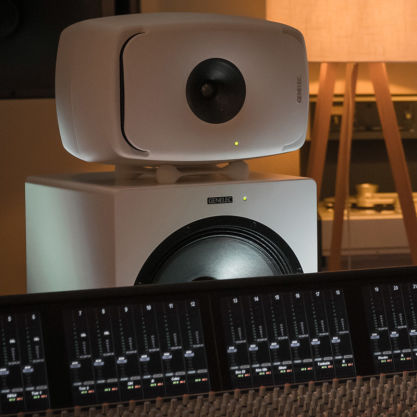Mit einem Frequenzgang bis hinunter zu 15 Hz und einem maximalen Schalldruckpegel von über 130 dB ist der 7382A der bisher leistungsstärkste Subwoofer von Genelec.
7382A
SAM™ Studio Subwoofer

Smart Active Monitor (SAM™)-Systeme

Optimierte Verstärker

SPL
129 dB

Frequenzgang
15 Hz - 100 Hz (-6 dB)

Abmessungen
H 625 x W 1400 x D 558 mm, (Anzeige in Inch)

Leistung und Flexibilität
Der 7382A kombiniert Leistung und Klarheit mit flexiblen Kalibrierungs- und Bassmanagementfunktionen und ist für den Einsatz in Aufnahmestudios, Filmmischstudios, Mastering-Suiten, Postproduktionshäusern und hochwertigen Heimkinos konzipiert. Er eignet sich auch für anspruchsvolle EDM-Wiedergabesysteme. Der 7382A bietet einen sehr hohen Schalldruck, eine niedrige untere Grenzfrequenz und geringe Verzerrungen und sorgt für eine präzise Bassartikulation selbst bei den tiefsten Frequenzen.
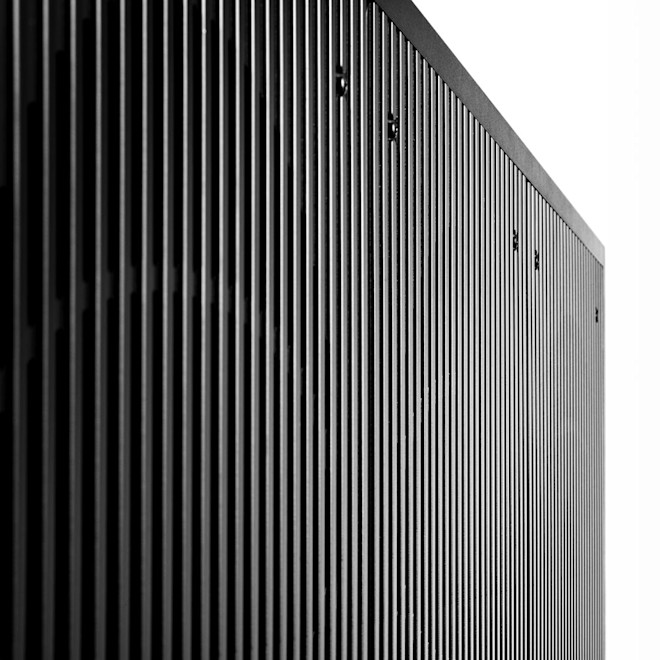
Optimales Abhören
Als Mitglied der wachsenden Smart Active Monitoring-Familie lässt sich der 7382A mit der GLM Software konfigurieren, kalibrieren und steuern. GLM bietet Kontrolle über das Bassmanagement, löst Probleme bei der Platzierung von Subwoofern in akustisch anspruchsvollen Räumen und ermöglicht bei Bedarf sogar die Erstellung ganzer Arrays von Genelec-Subwoofern. Als Teil eines SAM Systems sorgt der 7382A für ein optimales Hörerlebnis und garantiert Mischungen, die sich hervorragend übertragen.
Technische Spezifikationen

SPL
129 dB

Verstärkerleistung
2500 W Bass (Class D)

Frequenzgang
15 Hz - 100 Hz ("-6 dB")

Treiberabmessungen
3 x ⌀ 381 mm Bass (Anzeige in Inch)

Abmessungen
H 625 x W 1400 x D 558 mm, (Anzeige in Inch)

Gewicht
145 kg / 319.7 lb

Anschlüsse
3 x XLR Analog Input
2 x XLR Analog Output
1 x XLR AES/EBU Input
1 x XLR AES/EBU Output
2 x RJ45 Control
7382A SAM™ Studio Subwoofer
SAM™ Studio Subwoofer
Technische Spezifikationen
Mit einem Frequenzgang bis hinunter zu 15 Hz und einem maximalen Schalldruckpegel von über 130 dB ist der 7382A der bisher leistungsstärkste Subwoofer von Genelec.

Systemspezifikationen
Frequenzgang
Low cutoff -6dB
15 Hz
High cutoff -6dB
100 Hz

SPL
Peak SPL Maximum peak SPL output with random pink noise, measured in half space at 1 meter (Long term SPL output is limited by driver unit protection circuitry).
≥133 dB
Kurzzeitiger max. SPL Maximum short term sine wave SPL output averaged from 30 to 85 Hz, measured in half space at 1 meter.
≥129 dB
Eigenrauschen
Eigenrauschen Self generated noise at 1 m on axis (A-weighted).
≤5 dB SPL
Gewicht
Gewicht145 kg (319.7 lb)
Abmessungen
Höhe
625 mm
Breite
1400 mm
Tiefe
558 mm

Gehäuse
Gehäusetyp
Reflex port
Treiber
Treiber-Typ
Cone
Anzahl
3
Durchmesser
381 mm
Harmonische Verzerrung
Abschnitt Verstärker
Verstärker
2500 W Class D
Gewicht
11.3 kg
(24.9 lb)
Netzspannung
100-120VAC / 220-230VAC 50/60Hz
Stromverbrauch
ISS aktiv
≤13 W
Leerlauf
≤22 W
Volle Leistung
1500 W
Abschnitt Signalverarbeitung
Anschlüsse
3 x Input 2 x Analog XLR input connectors XLR female, balanced 10 kOhm.
1 x Analog LFE IN.
2 x Output 2.0 Analogue XLR output connectors XLR male.
Input Digital signal input connector XLR female 110 Ohm.
Output Digital signal output / Thru connector XLR male 110 Ohm.
2 x Control Two CAT5 (RJ45) GLM Network connectors for computer control using the Genelec Loudspeaker Manager (GLM) software.
Produktvarianten
Produktcodes
Weitere technische Details finden Sie in der Anleitung.
Schlüsseltechnologien

Smart Active Monitor (SAM™)-Systeme

Optimierte Verstärker

Intelligent Signal Sensing (ISS™)-Technologie

Bass Management

Schutzschaltungen

Aktive Frequenzweichen
Unsere vernetzten Smart Active Monitor (SAM™)-Systeme verfügen über eine automatische Anpassung an Ihre Hörumgebung.

In den letzten zehn Jahren hat die Erstellung von Medieninhalten weltweit rapide zugenommen, was zu erheblichen Veränderungen in der Art und Weise geführt hat, wie Einrichtungen mit der gestiegenen Arbeitsbelastung umgehen. Mehr denn je findet eine wachsende Zahl von Audioproduktionen in kleineren, engeren Arbeitsumgebungen statt. Dadurch verstärken sich häufig akustische Probleme und die Zuverlässigkeit beim Abhören sinkt. Gleichzeitig muss man sich als Profi auf ein präzises Abhörsystem verlassen können, das den Klang neutral und ohne Verfärbungen wiedergibt.
Aufbauend auf den bewährten elektroakustischen Grundlagen unserer Produkte der Serien 1200, 8000 und 7000 sind die fortschrittlichen SAM-Systeme von Genelec die modernsten und flexibelsten Abhörlösungen von heute. Sie sind ein unverzichtbares Werkzeug für Audioprofis, da sie sich automatisch an die akustische Umgebung anpassen und Pegel, Verzögerungen und Frequenzgang korrigieren können. SAM-Systeme können über das Genelec-eigene Loudspeaker Manager (GLM™)-Netzwerk und die entsprechende Software gesteuert werden, so dass Sie ein äußerst flexibles und zuverlässiges Abhörsystem aufbauen können.
Die GLM-Software ist ein intuitives und leistungsfähiges Monitorsteuerungs-Netzwerksystem, das die Verbindung zu allen SAM-Studiomonitoren und Subwoofern im Netzwerk verwaltet - mehr als 80 Geräte falls notwendig. Sie ermöglicht die Einstellung von Pegeln, Abstandsverzögerungen und eine Anpassung des Frequenzgangs mit dem intelligenten automatischen Kalibrierungsalgorithmus AutoCal™. Alle Parameter und Einstellungen werden in System-Setup-Dateien oder für den Stand Alone-Betrieb in jedem einzelnen Monitor oder Subwoofer gespeichert.
Außerdem können alle akustischen Eigenschaften der SAM-Systeme für verschiedene Arbeitsstile oder Kundenanforderungen optimiert werden. Auch ween Sie zwischen verschiedenen Räumen wechseln, können Sie von der SAM-Technologie profitieren und ein Höchstmaß an Konsistenz beim Monitoring erreichen.
Genelec SAM-Systeme bieten eine umfassend skalierbare, lösungsorientierte, intelligent vernetzte Produktpalette, die analoge und digitale Signale in praktisch jeder Arbeitsumgebung unterstützt.
Jeder Treiber wird von einem eigenen, optimierten Verstärker angesteuert.

Elektronische Frequenzweichen ermöglichen es, das Audiosignal in einzelne Frequenzbänder aufzuteilen, die separat an einzelne Leistungsverstärker geleitet werden können, die dann an spezielle, für ein bestimmtes Frequenzband optimierte Schallwandler angeschlossen werden.
In einem typischen 2-Wege-Lautsprechersystem benötigt die aktive Frequenzweiche zwei Leistungsverstärker - einen für den Tieftöner und einen für den Hochtöner. Die Leistungsverstärker werden direkt an die Chassis eines Aktivlautsprechers angeschlossen, wodurch die Belastung des Leistungsverstärkers viel einfacher ermittelt werden kann. Jeder treiberspezifische Leistungsverstärker hat nur einen begrenzten Frequenzbereich zu verstärken (der Leistungsverstärker wird nach der aktiven Frequenzweiche platziert), was die Konstruktion noch einfacher macht.
Das Aktivprinzip bietet mehrere Vorteile:
- Die Leistungsverstärker sind direkt mit den Lautsprechertreibern verbunden, wodurch die Kontrolle durch die Dämpfung des Leistungsverstärkers auf die Schwingspule des Treibers maximiert und die Folgen dynamischer Änderungen der elektrischen Eigenschaften des Treibers verringert werden. Dies kann das Einschwingverhalten des Systems verbessern.
- Der Leistungsbedarf des Endverstärkers ist geringer. Da in den passiven Frequenzweichen-Filterkomponenten keine Energie verloren geht, wird die erforderliche Verstärkerleistung erheblich reduziert (in einigen Fällen um bis zu 50%), ohne dass die akustische Leistung des Lautsprechersystems verringert wird. Dadurch können Kosten gesenkt und die Audioqualität und Zuverlässigkeit des Systems erhöht werden.
- Kein Verlust zwischen Verstärker und Treibereinheiten führt zu einer maximalen akustischen Effizienz
- Mit aktiver Technologie kann eine überragende Klangleistung im Verhältnis zur Größe und zur Leistung bei niedrigen Frequenzen erzielt werden
- Alle Lautsprecher werden als werkseitig aufeinander abgestimmtes System geliefert (Verstärker, Frequenzweichen-Elektronik und Gehäuse-Treiber-Systeme)
Intelligent Signal Sensing (ISS™) zur Reduzierung des Stromverbrauchs und automatische Nutzung des Standby-Modus.

Die Anfang 2013 eingeführte Intelligent Signal-Sensing-Technologie von Genelec wurde entwickelt, um sowohl die ErP-Richtlinien der Europäischen Union als auch die umfassenderen Nachhaltigkeitsverpflichtungen des Unternehmens zu erfüllen.
Die Intelligent Signal Sensing, ISS™-Schaltung verfolgt den Signaleingang des Lautsprechers und erkennt, ob er genutzt wird. Wenn der ISS-Schaltkreis über einen bestimmten Zeitraum kein Audiosignal am Eingang findet, versetzt er den Lautsprecher in einen energiesparenden Ruhezustand und der Lautsprecher verbraucht weniger als 0,5 Watt. Wenn ein Eingangssignal erkannt wird, schaltet sich der Lautsprecher sofort wieder ein.
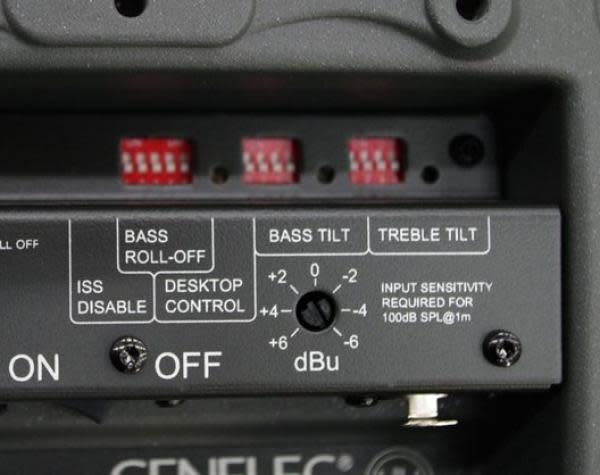
Wenn diese Funktion nicht genutzt werden soll, kann ISS™ deaktiviert werden, indem der DIP-Schalter "ISS Disable" auf der Rückseite in die Position "ON" gestellt wird. In diesem Modus wird der Monitor nur über den Netzschalter ein- und ausgeschaltet.
Beachten Sie, dass der Netzschalter den Monitor immer vollständig ausschaltet.
Nachfolgend finden Sie eine Liste der Bedingungen, die verhindern, dass der Monitor oder Subwoofer in den ISS-Ruhezustand versetzt wird:
- Am Analogeingang wird ein Signal erkannt.
- Am Digitaleingang wird ein Signal erkannt. Das kann auch das Clocking-Signal Ihrer Quelle sein, das auch anliegt, wenn kein Audio wiedergegeben wird.
- Das GLM-Netzwerk ist aktiv und GLM läuft. GLM 5 bietet eine eigene ISS Funktion an.
- ISS ist deaktiviert.
Es ist üblich, dass digitale Audioquellen das Clocking-Signal senden, sobald die Quelle eingeschaltet ist. Dies verhindert, dass der Monitor oder Subwoofer in den Ruhezustand übergeht. Es könnte auch ein Rauschen im analogen Eingangssignal vorhanden sein, das den Ruhezustand von ISS verhindert. Um herauszufinden, an welchem Eingang ein Signal anliegt, das das Umschalten in den ISS-Ruhezustand verhindert, entfernen Sie jedes Kabel einzeln und prüfen Sie, ob der ISS-Ruhezustand aktiviert wird.
Das Bass Management verarbeitet den Tiefbassanteil für mehrere Kanäle.
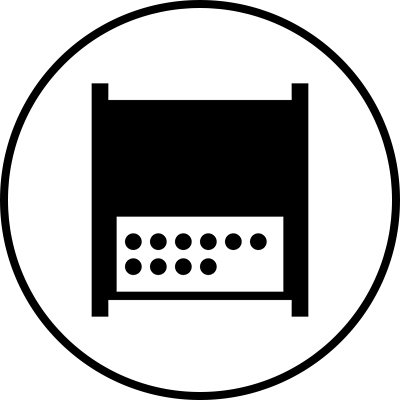
Das Prinzip des Bassmanagements besteht darin, dass Bassanteile von Audio-Kanälen nur von Lautsprechern wiedergegeben werden, die dazu in der Lage sind, unabhängig davon, ob es sich um die Hauptlautsprecher des Systems oder um einen oder mehrere Subwoofer handelt.
Bei der Stereowiedergabe sollten im Idealfall Signale von 20 Hz bis 20 kHz wiedergegeben werden. Große Mehrwege-Abhörsysteme können diesen großen Frequenzbereich abdecken. Bei Mehrkanalton sollten professionelle und Consumer-Audiosysteme ebenfalls in der Lage sein, Audiosignale bis in den Bassbereich für jeden Kanal wiederzugeben. Um dies zu erreichen, sollten Hauptmonitore, Subwoofer und Frequenzweichen-Elektronik zusammenarbeiten.
Ein Bassmanagementsystem verwendet entweder analoge elektronische Schaltkreise oder softwarebasierte Filter, die tieffrequente Informationen aus den Hauptkanälen filtern und an einen oder mehrere Subwoofer weiterleiten.
Der separate LFE (Low Frequency Effects)-Kanal kann auch über diesen oder diese Subwoofer abgehört werden und wird zu den tiefen Frequenzen der anderen Hauptkanäle hinzugefügt. Das grundlegende und wichtigste Ziel des Bassmanagements besteht also darin, sicherzustellen, dass die gesamte Audiobandbreite aller Kanäle bewertet werden kann.

Die Vorteile von Bass Management
- Der Subwoofer erweitert den Frequenzgang des Systems an der unteren Grenze des hörbaren Bereichs.
- Der Monitor kann einen höheren maximalen Schallpegel erzeugen, wenn er keine tiefen Frequenzen wiedergeben muss.
- Optimierte Tieftonwiedergabe durch Auswahl eines geeigneten Standorts für den Subwoofer; auch die Monitore können freier aufgestellt werden.
- Der Ausgang des Subwoofers ist in Pegel und Phase auf die Monitore abgestimmt, was eine neutrale und präzise Wiedergabe bis hinunter zu 19 Hz (je nach Modell sogar 15 Hz) und über den Crossover-Punkt ermöglicht.
- Der Ausgangspegel des LFE-Kanals (0 oder +10 dB im Vergleich zu den Hauptkanälen) kann an das Quellformat angepasst werden.
- Die Möglichkeit, den Subwoofer zu umgehen, erlaubt es, den hörbaren Einfluss des Subwoofers zu bewerten.
Hochentwickelte Schutzschaltungen für die Treiber garantieren einen sicheren Betrieb.
In kritischen Produktionsumgebungen ist es unerlässlich, dass Abhörsysteme jederzeit zuverlässig und voll funktionsfähig arbeiten. Einer der Hauptgründe für den großen Erfolg von Genelec in Rundfunk- und Fernsehumgebungen ist die Zuverlässigkeit unserer Produkte. Ein Schlüsselelement für diese Zuverlässigkeit ist die interne Schutzschaltung, die seit 1978 in allen Produkten enthalten ist.
Die Schutzschaltung verhindert Treiberausfälle, indem sie Signalpegel erkennt und bei plötzlichen Pegelspitzen oder konstant zu hohen Pegeln den Signalpegel automatisch absenkt. Natürlich beeinträchtigt diese Funktion in keiner Weise die Klangqualität der Lautsprecher, wenn sie innerhalb der Spezifikationen arbeiten, sondern verhindert nur, dass zu hohe Eingangssignale den Lautsprecher zerstören.
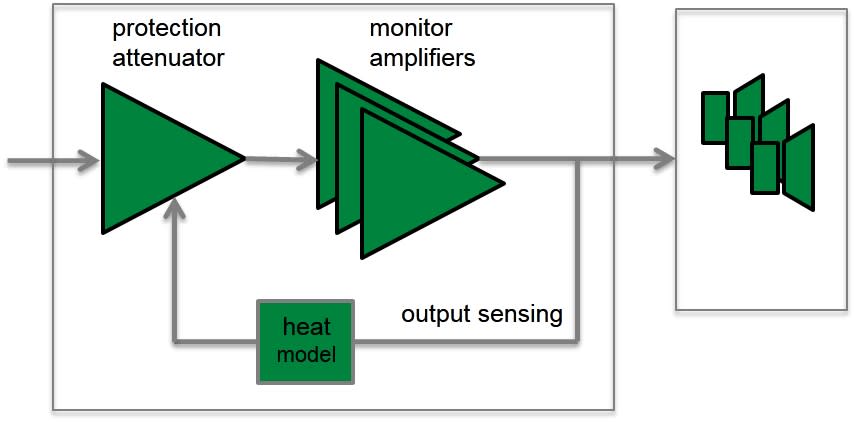
Merkmale und Vorteile der Schutzschaltungen:
- Reduziert den Ausgangspegel bei Bedarf (z. B. wenn die Temperatur der Schwingspule des Treibers den sicheren Grenzwert erreicht), was die Zuverlässigkeit des Systems erheblich verbessert
- Geeignete Schutzschaltungen in allen Lautsprechern und Subwoofern ermöglichen eine Maximierung des Systemausgangsschallpegels.
Aktive Frequenzweichen, die mit niedrigen Signalpegeln arbeiten.

Elektronische Frequenzweichen ermöglichen die Aufteilung des Audiosignals in einzelne Frequenzbänder, die separat an einzelne Leistungsverstärker geleitet werden können, die dann an spezifische, für ein bestimmtes Frequenzband optimierte Wandler angeschlossen werden.
Aktive Frequenzweichen gibt es sowohl in digitaler als auch in analoger Ausführung. Die digitalen aktiven Frequenzweichen von Genelec beinhalten zusätzliche Signalverarbeitung wie Schutzschaltungen, Verzögerung und Entzerrung.
Analoge aktive Frequenzweichen von Genelec enthalten elektronische Komponenten, die mit niedrigen Signalpegeln betrieben werden, die für die Eingänge von Leistungsverstärkern geeignet sind. Dies steht im Gegensatz zu passiven Frequenzweichen, die mit den hohen Signalpegeln der Endverstärkerausgänge arbeiten und dabei hohe Ströme und in einigen Fällen auch hohe Spannungen verarbeiten müssen.
In einem typischen 2-Wege-System benötigt die aktive Frequenzweiche zwei Leistungsverstärker - einen für den Tieftöner und einen für den Hochtöner.
Das Design der aktiven Frequenzweiche bietet mehrere Vorteile:
- Der Frequenzgang wird unabhängig von dynamischen Änderungen der elektrischen Eigenschaften des Treibers oder des Treiberpegels.
- Es besteht eine erhöhte Flexibilität und Präzision bei der Einstellung und Feinabstimmung jedes Ausgangsfrequenzgangs für die verwendeten Treiber.
- Jeder Treiber hat seine eigene Signalverarbeitung und seinen eigenen Leistungsverstärker. Dadurch wird jeder Treiber von den Treibersignalen der anderen Treiber isoliert, was Intermodulationsverzerrungen und Übersteuerungsprobleme reduziert.
- Empfindlichkeitsschwankungen zwischen den Treibern können kompensiert werden.
- Frequenz- und Phasenganganomalien, die mit den Eigenschaften eines Treibers innerhalb des vorgesehenen Durchlassbereichs verbunden sind, können kompensiert werden.
- Der neutrale Frequenzgang eines hochwertigen Aktivlautsprechers ist das Ergebnis der kombinierten Wirkung des Frequenzweichenfilters, des Leistungsverstärkers und der Treiber in einem Lautsprechergehäuse.
Die Verwendung des aktiven Ansatzes ermöglicht die Anpassung und Optimierung des Frequenzgangs des gesamten Lautsprechersystems in verschiedenen Raumumgebungen ohne teure externe Equalizer. Das Endergebnis ist ein einfacheres, zuverlässigeres, effizienteres, konsistenteres und präziseres aktives Lautsprechersystem.
Referenzen
Genelec UNIO Explained | How the ecosystem offers seamless in-room and personal headphone monitoring
Using GLM | Walkthrough
Using GLM | The foundations
Using GLM | Controlling GLM with MIDI
Using GLM | GRADE Room Acoustic Report
Using GLM | Calibration Group IDs
Using GLM | Accounts and product registration
Using GLM | The technical details
Genelec UNIO Explained | How the ecosystem offers seamless in-room and personal headphone monitoring
A quick guide to our UNIO Ecosystem – which offers audio engineers seamless bridging of in-room and personal headphone monitoring. https://genelec.com/UNIO
The Genelec UNIO Ecosystem – which combines the power of our renowned GLM, SAM Monitoring and Aural ID adaptive technologies – gives audio engineers the flexibility to work anywhere, anytime, from stereo to immersive. And now, with the new UNIO Personal Reference Monitoring (PRM) solution, audio professionals benefit from the pinpoint accuracy of our pioneering active monitoring headphone solution, which combines the 9320A SAM Reference Controller with uniquely factory-calibrated 8550A Professional Reference Headphones.
To learn more, visit https://genelec.com/UNIO
Händler finden

Dokumentation
Dokumente
Operating Manual 7382A Brochure 7382A Immersive Solutions Brochure 7382A Operating Manual (Chinese)FAQ
The Classic 8000 Series monitors have an analogue input. The 7200 Series SAM subwoofers have AES/EBU digital outputs only. However, other 7300 Series SAM subwoofers have analogue inputs and outputs and can be used also with analogue monitors.
Which SAM™ Products You Are Going to Mix With the Classic 8000 Series?
Mixing 8000 Series and SAM™ monitors is not recommended
We do not recommend mixing Classic 8000 Series monitors with SAM™ Monitors.
If the analogue input sensitivity of 8000 Series and SAM™ Series monitors are the same, Genelec SAM™ Monitors exhibit a slightly larger latency (< 5 ms) than 8000 Series monitors. Therefore Classic 8000 Series and SAM™ Series monitors should not be mixed in a stereo pair or multichannel setup.
It is alright to mix Classic 8000 Series with SAM™ Subwoofers
However, it is okay to mix the Classic 8000 Series monitors with SAM™ Subwoofers. Any Classic 8000 Series monitors can be used with SAM™ Subwoofers, in any stereo or multichannel setup.
Setting the room response calibration controls
Genelec monitors are calibrated flat in anechoic free field conditions. When the monitor is placed in a room close to walls or other boundaries, the low frequency output of the monitor increases. To achieve a flat low frequency response an adjustment of typically -4 dB on the bass tilt control is used. Genelec also provides a bass roll-off control to compensate for any remaining excessive LF energy around the low cut-off frequency.
Genelec GLM AutoCal can implement a more precise compensation after measuring the acoustic effects produced by the monitor’s installation location.
Differences in room reverberation time and listening distance can lead to changes being required in the treble region so treble tilt is fitted to most of the models in the Genelec range.
In three-way monitors and large main systems there are additional driver controls for the bass level, mid level and treble level which enable very fine adjustment of the frequency response so that the monitors can be placed in many different listening environments, whilst still achieving a consistent and neutral sound reproduction.
The best way to set the room response controls of a Genelec monitor is by taking an acoustical measurement at the listening location, using a measurement system for those products that offer local controls (DIP switches) on the monitor or subwoofer, or by using GLM AutoCal for the SAM™ (Smart Active Monitoring) products.









